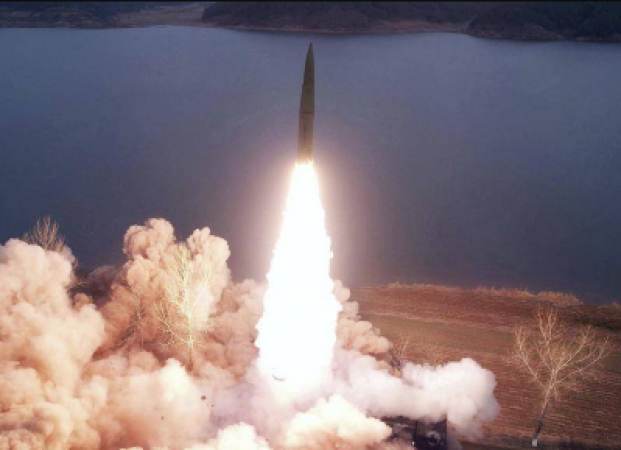
Pyon yong: As South Korean President Yoon Suk Yeol travelled to Tokyo for a summit to strengthen ties in the face of Pyongyang's increasing aggression, Seoul claimed that North Korea had fired a "long-range ballistic missile" on Thursday.
The launch was North Korea's third military display since Sunday and coincided with the biggest joint military exercises between South Korea and the US in the previous five years.
The Joint Chiefs of Staff of South Korea reported to AFP that "our military detected one long-range ballistic missile fired from around the Sunan area in Pyongyang." They identified the missile as an ICBM-class missile.
Also Read: Nowadays WhatsApp's New update can displays user profiles in group chats
The missile was launched on a lofted trajectory, which is typically used to avoid overflying neighbouring nations, and it travelled about 1,000 kilometres (620 miles), according to the JCS.
Yoon demanded increased trilateral cooperation with Japan and the US at a National Security Council meeting, saying that "North Korea will pay a clear price for such reckless provocations," according to a statement from his office.
The missile's maximum altitude, according to Japan's cabinet office, was over 6,000 km. Reporters were informed by Prime Minister Fumio Kishida that he would meet with National Security Council ministers. It's crucial to maintain peace and stability in the area, Kishida continued.
Hours before the leaders of South Korea and Japan were scheduled to meet in Tokyo and with Pyongyang's missile and nuclear programmes high on the agenda, there was a launch on Thursday.
The two neighbours are attempting to repair their diplomatic ties, which have been severely strained by Japanese atrocities committed during its 35-year colonial rule, at the first summit in 12 years.
Also Read: Prior to securing funding First Republic spoke with private equity
Yoon has stated that increased defence spending and joint military exercises are crucial for maintaining regional and international stability.
Yoon said in a written interview with media, including AFP, ahead of his trip, "There is an increasing need for Korea and Japan to cooperate in this time of a polycrisis with North Korean nuclear and missile threats escalating.
According to analysts, North Korea timed the launch on the day of the summit for "double effect" as a warning to its neighbours and in opposition to the joint drills between the US and South Korea.
Earlier this month, North Korean leader Kim Jong Un commanded the military to step up training in order to get ready for a real conflict. It's the perfect time for Kim to launch his missiles because North Korea is always looking for justifications for its hostile actions and weapons development, according to Soo Kim, a former CIA Korea analyst who is now employed by the management consulting firm LMI.
The test, according to Leif Easley, a professor at Seoul's Ewha University, was an effort by Kim "to threaten Tokyo for deepening trilateral cooperation with Washington and Seoul and to coerce South Korea from holding further defence exercises with the United States."
In response to growing military and nuclear threats from the North, which has recently carried out a series of increasingly provocative banned weapons tests, Seoul and Washington have increased defence cooperation.
Following the launch of two strategic cruise missiles from a submarine on Sunday, just hours before the start of the US-South Korea exercises, North Korea launched two short-range ballistic missiles on Tuesday.
The 10-day Freedom Shield drills, which began on Monday, are scheduled to take place. According to the allies, the Freedom Shield training focuses on the "changing security environment" brought on by North Korea's increased aggression.
All of these drills are seen as invasion practise by North Korea, which has repeatedly threatened to respond with "overwhelming" force. The test on Thursday "might be a practise run for a normal angle ICBM launch or it might be a check-up in the North's preparations for a reconnaissance satellite launch," Yang Moo-jin, a professor at the University of North Korean Studies in Seoul.
Also Read: US ambassador says there is no place for US drones near Russia
Analysts wonder if North Korea has the technology to build missiles that can survive re-entry into the atmosphere since it has never launched one of its most potent missiles on a normal trajectory.
A military reconnaissance satellite launch is one of Pyongyang's top priorities, according to previous statements made by the country, which last year declared itself a "irreversible" nuclear power.